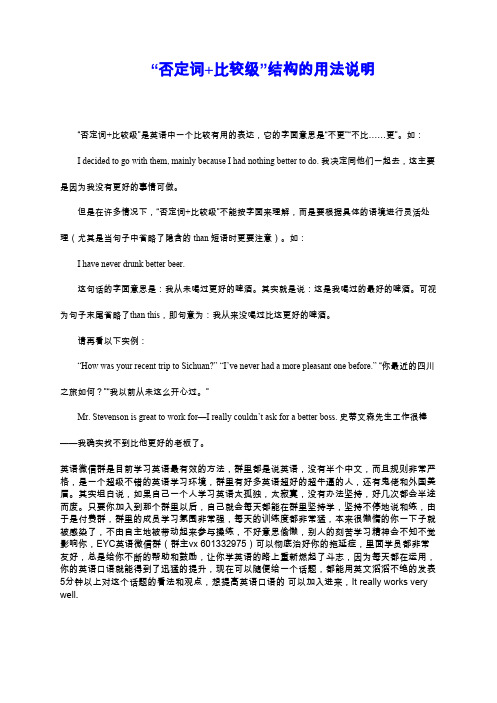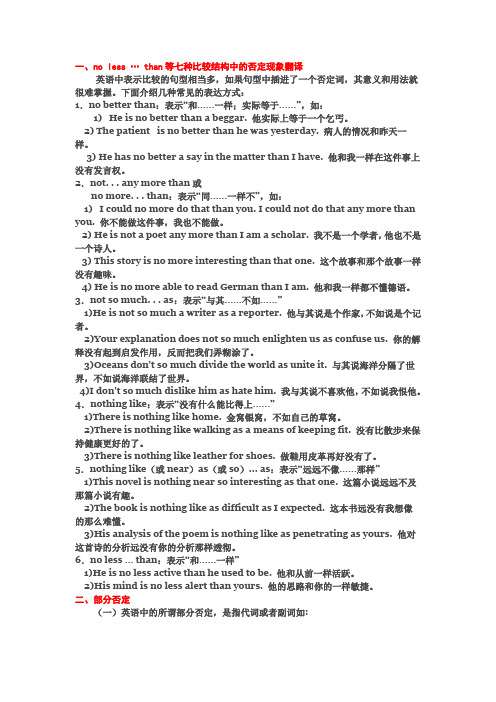“否定词+比较级+than”结构
- 格式:doc
- 大小:11.50 KB
- 文档页数:1

浅析含than的几种比较结构在中学英语教材中,含than的比较结构较多,情况比较复杂:有些结构看似相同或相似,但其用法及所表示的意义却不大相同;有些结构不同,却表示相同的意义;有些虽是比较结构,但并无比较意义;还有些结构其形式是背定的,却常表示委婉的否定概念。
这些结构很容易被混淆而导致错误的表达或理解。
下面浅析这几种比较结构。
一、more than...与more...than...1.more than...(1)后接数词,译为“超过”“......以上”。
例如:More than twenty people were injured in the accident.二十多人在事故中受伤。
More than twenty thousand people attended the celebration rally.两万多人参加了庆祝大会。
(2)后接形容词、副词或动词,译为“很”“非常”。
例如:The teacher is more than kind to us.老师对我们很好。
He was more than pleased with her performance.他对她的表演非常满意。
The boy was more than slightly hurt.这男孩伤得不轻。
This more than satisfied us. 这使我们十分满意。
The discovery of new mines will more than increase the coal output of our country .新煤矿的发现将极大地增加我国的煤产量。
(3)后接名词,译为“不只是”“不止”或“不仅”。
例如:Science is more than a mere accumulation of carefully collected facts ; it is also a method of solving problems.科学不仅是精心收集的事实的积累,它还是一种解决问题的办法。

“否定词+比较级”结构的用法说明“否定词+比较级”是英语中一个比较有用的表达,它的字面意思是“不更”“不比……更”。
如:I decided to go with them, mainly because I had nothing better to do. 我决定同他们一起去,这主要是因为我没有更好的事情可做。
但是在许多情况下,“否定词+比较级”不能按字面来理解,而是要根据具体的语境进行灵活处理(尤其是当句子中省略了隐含的than 短语时更要注意)。
如:I have never drunk better beer.这句话的字面意思是:我从未喝过更好的啤酒。
其实就是说:这是我喝过的最好的啤酒。
可视为句子末尾省略了t han this,即句意为:我从来没喝过比这更好的啤酒。
请再看以下实例:“How was your recent trip to Sichuan?” “I’ve never had a more pleasant one before.” “你最近的四川之旅如何?”“我以前从未这么开心过。
”Mr. Stevenson is great to work for—I really couldn’t ask for a better boss. 史蒂文森先生工作很棒——我确实找不到比他更好的老板了。
英语微信群是目前学习英语最有效的方法,群里都是说英语,没有半个中文,而且规则非常严格,是一个超级不错的英语学习环境,群里有好多英语超好的超牛逼的人,还有鬼佬和外国美眉。
其实坦白说,如果自己一个人学习英语太孤独,太寂寞,没有办法坚持,好几次都会半途而废。
只要你加入到那个群里以后,自己就会每天都能在群里坚持学,坚持不停地说和练,由于是付费群,群里的成员学习氛围非常强,每天的训练度都非常猛,本来很懒惰的你一下子就被感染了,不由自主地被带动起来参与操练,不好意思偷懒,别人的刻苦学习精神会不知不觉影响你,EYC英语微信群(群主vx 601332975)可以彻底治好你的拖延症,里面学员都非常友好,总是给你不断的帮助和鼓励,让你学英语的路上重新燃起了斗志,因为每天都在运用,你的英语口语就能得到了迅猛的提升,现在可以随便给一个话题,都能用英文滔滔不绝的发表5分钟以上对这个话题的看法和观点,想提高英语口语的可以加入进来,It really works very well.。

一、no less … than等七种比较结构中的否定现象翻译英语中表示比较的句型相当多,如果句型中插进了一个否定词,其意义和用法就很难掌握。
下面介绍几种常见的表达方式:1.no better than:表示“和……一样;实际等于……”,如:1) He is no better than a beggar. 他实际上等于一个乞丐。
2) The patient is no better than he was yesterday. 病人的情况和昨天一样。
3) He has no better a say in the matter than I have. 他和我一样在这件事上没有发言权。
2.not. . . any more than或no more. . . than:表示“同……一样不”,如:1) I could no more do that than you. I could not do that any more than you. 你不能做这件事,我也不能做。
2) He is not a poet any more than I am a scholar. 我不是一个学者,他也不是一个诗人。
3) This story is no more interesting than that one. 这个故事和那个故事一样没有趣味。
4) He is no more able to read German than I am. 他和我一样都不懂德语。
3.not so much. . . as:表示“与其……不如……”1)He is not so much a writer as a reporter. 他与其说是个作家,不如说是个记者。
2)Your explanation does not so much enlighten us as confuse us. 你的解释没有起到启发作用,反而把我们弄糊涂了。

than的语法知识Than的语法知识Than是一个常见的比较词,用于进行比较,表示一个事物相对于另一个事物的优劣或差异。
在语法中,than通常用于比较两个物体、人或概念之间的差异。
下面将介绍一些关于than的语法知识。
1. than的用法than通常用于表示比较两个事物之间的差异。
它可以和形容词、副词、名词或动词连用。
在比较级中,than用于连接两个要进行比较的事物,表示后者相对于前者的优劣或差异。
例如:- She is taller than her sister.(她比她姐姐高。
)- He runs faster than me.(他跑得比我快。
)2. than的位置than通常紧跟在比较级形容词或副词之后,用于连接两个要进行比较的事物。
例如:- He is smarter than his classmates.(他比他的同学聪明。
)- She sings better than her friend.(她唱得比她的朋友好。
)3. than的否定形式当要表示两个事物在某一方面没有差异时,可以使用not...than的形式。
例如:- This book is not more expensive than that one.(这本书并不比那本书贵。
)- I don't like him any less than you do.(我和你一样不喜欢他。
)4. than的使用注意事项- 在比较级中,than用于表示后者相对于前者的优劣或差异。
如果要表示两个事物在某一方面相同,则使用as...as结构。
例如:- He is as tall as his brother.(他和他的兄弟一样高。
)- This car is as fast as that one.(这辆车和那辆车一样快。
)- 当比较的两个事物具有相同的特征时,可以使用more...than的形式。
例如:- She is more beautiful than ever.(她比以前更漂亮。

than的用法归纳总结than是一个常用的连词,常用于比较两个事物、人或者状态之间的程度、差别、相似等情况。
than的具体用法可以分为以下几种:1. 比较两者之间的数量、程度等:A+比较级+than+B。
例如:He is taller than his brother.2. 比较两者之间不同的特点、品质等:A+形容词+than+B。
例如:She is more intelligent than her classmates.3. 比较两个动作或状态之间的优劣、远近、高低的关系:A+动词原形+than+B。
例如:I would rather stay at home than goout to see a movie.4. 表示“不是……而是……”的转折关系:否定词+比较级+than。
例如:He is not more intelligent than me.5. 表示与其它事物、人的区别:A is different from/to/ than B。
例如:His opinion is very different from/to/ than mine.6. 表示与其它事物、人相比有一个更高的程度:A is more +形容词/副词+than B。
例如:She is more beautiful than her sister.7. 表示与其它事物、人相比有一个更低的程度:A is less+形容词/副词+than B。
例如:This car is less expensive than that one.需要注意的是,than不仅用于比较级中,还可以和as连用表示“和……一样”,例如:She is as tall as her father。

⽐较级结构(comparative Construction):more…than 结构more...than结构形容词或副词⽐较级than-分句基本模式:形容词或副词⽐较级1.基本模式:否定形式:less…than(不如not so /as …as普通)也可以⽤:not as / so …asThis parcel is heavier than that one.This parcel is less heavy than that one.This parcel is not so / as heavy as that one.This car runs faster than that one.This car runs less fast than that one.This car doesn’t run so/ as fast as that one.2.变体:more / less / fewer +名词 + than-分句She has written more essays than he.I have done more work this morning than he.I spent less money on clothing than my sister.There are fewer visitors today than yesterday.3.不定冠词/零冠词 +形容词⽐较级+名词+ than-分句My brother has a larger house than mine.The slaves were given worse food than that for their master’s dogs.4.名词词组 + more …than结构作后置修饰语There are men more intelligent tha John.John is a worker more efficient than Jack.注意:以下词序偶尔可见,却不普通。
than的用法归纳总结1. 表示比较级若用于比较级,则表示“比…更…”,用法为:“A + 比较级+ than + B”。
例句:- He is taller than his brother.(他比他的兄弟更高。
)- This book is more interesting than that one.(这本书比那本书更有趣。
)2. 表示时间、数量、程度than还可以用于表示时间、数量、程度等方面的比较,用法为:“A + 比较级+ than + B”。
例句:- I think you need to drink more water than you do now.(我认为你需要比现在喝更多的水。
)- He finished the work earlier than we expected.(他比我们预计的完成得更早。
)- She was more nervous than he was before the exam.(她在考试前比他更紧张。
)3. 与否定词连用表示否定意义than还可以与否定词连用表示否定意义,用法为:not + 比较级+ any more thanno more + 比较级+ than例句:- I don't like him any more than you do.(我和你一样都不喜欢他。
)- There was no more than five people at the party.(派对上只有不到五个人。
)4. 条件状语从句中的使用在条件状语从句中,than的作用是连接主从句,用法为:“A + than + B”。
例句:- If you work harder than before, you will get better grades.(如果你比以前更努力,你会得到更好的成绩。
)5. 用于as...as...结构在as...as...结构中,than可以用作替代词,用法为:“as + adj/adv + as + than”。
比较级的六种用法结构-回复比较级的用法结构有很多种,根据不同的语境和场景,可以灵活运用。
以下将逐步解释六种常见的比较级用法结构,并给出示例和解析。
1. 形容词/副词+ 比较级+ than...这种结构用于进行两个对象或主题的比较,强调其中一方相对另一方更具有某种质量或性质。
例句:- She is taller than her sister.(她比她妹妹高。
)- This phone runs faster than the old one.(这部手机比旧手机运行得更快。
)解析:这种结构中,形容词或副词的比较级在句中作为修饰词,用于说明两个主题之间在某个方面的差异。
2. The + 比较级, the + 比较级这种结构用于表示随着一方的变化,另一方也相应发生变化的关系。
例句:- The more you practice, the better you will get.(你练习得越多,表现就会越好。
)- The earlier you arrive, the more choices you will have.(你越早到,你会有更多的选择。
)解析:两个比较级分别放在"The more...,the more..."的结构中,表示两者之间的因果关系或相关性。
第一个比较级表示因,第二个比较级表示果。
3. 比较级+ and + 比较级这种结构用于描述某个对象具备两种或多种质量或性质。
例句:- The film is funny and interesting.(这部电影既好笑又有趣。
)- The new car is fast and comfortable.(新车快且舒适。
)解析:通过使用并联连词"and"将两个比较级连接起来,来表示两种或多种品质的组合。
4. 比较级+ than ever before这种结构用于表示某种质量或性质的增强或程度的提高。
例句:- I am busier than ever before.(我比以往更忙。
than句子结构句子结构是语言学中的一个重要概念,它指的是描述句子组成部分和它们之间关系的规则和模式。
其中,"than"句子结构是一种常见的比较结构,在英语中用于表达两个事物之间的比较关系。
本文将探讨"than"句子结构的用法、例句以及一些相关注意事项。
一、"than"句子结构的基本用法"than"句子结构用于比较两个事物之间的差异或相似性。
它通常由两个句子构成,其中一个是主句,另一个是从句,从句中使用"than"引导比较的对象。
句子结构的形式可以是肯定句、否定句、疑问句和感叹句。
以下是一些常见的"than"句子结构的例子:1.肯定句结构:- The sun is brighter than the moon.(太阳比月亮亮。
)- She is taller than her brother.(她比她兄弟高。
)2.否定句结构:- This book is not more interesting than the previous one.(这本书不比前一本有趣。
)- He is not less intelligent than his classmates.(他不比他的同学笨。
)3.疑问句结构:- Is English more difficult than Chinese?(英语比中文更难吗?)- Are you taller than your sister?(你比你妹妹高吗?)4.感叹句结构:- How much faster is the new computer than the old one!(这台新电脑比旧电脑快多少啊!)- What a better idea than mine!(这个比我的主意好多了!)二、"than"句子结构注意事项在使用"than"句子结构时,需要注意以下几点:1.注意主句和从句的主谓一致。
怎样理解no(nothing)more(…)than?----由一道高考题所引发的思考2005年高考试题湖南卷(以下简称05湖南卷)阅读理解部分的D篇和某地高中毕业班第一次诊断性检测题(以下简称某地一诊题)基本上相同。
然而在这篇文章后的阅读理解题目中最后一题的D选项,某地一诊题作了含义完全相反的改动,在题干和其它三个选项含义完全相同的情况下,这两套题所给的正确答案竟然都是D选项。
究竟哪套题出了差错,还得从这篇阅读材料谈起。
From Mr. Ward Hoffman.Sir, I was halfway through Professor Raj Persaud’s article “What’s the tipping point?”(Financial Times Weekend, April 9-10)when it occurred to me that what I was reading was not ironic(讽刺的).If Prof (Professor) Persaud wants to know why Americans tip in restaurants, he need only ask (needs only to ask) the first American he meets in London.Americans tip in restaurants for one reason, and one reason only: we tip to supplement(补贴)the salary of restaurant workers. Quality of service does not enter into it, beyond the fact that one may tip a bit less for poor service, or a little (bit) more for good service.Not tipping at all in a non-fast-food restaurant is not a choice. In the US, one used to tip about 15 per cent for dining(dinning)in a family-style restaurant or in an upmarket(高档的)(a top-level)restaurant. Here, in San Francisco Bay area restaurants, we are encouraged to tip 20 per cent or more, to help restaurant workers live in this very expensive area.After eating at an Italian restaurant in my city, I left a tip of 20 per cent on the non-tax part of our dinner bill. It was expected. There is nothing more complicated(复杂的)than that aboutAmericans(American)tipping in restaurants.Ward Hoffman,Palo Alto, CA94306, USFrom Mr. Philip McBride Johnson.Sir, I agree with most of Raj Persaud’s opinions(opinion)about the doubtful value of tipping, but with one exception(例外).Tips can be very useful when one is a repeat customer or diner.It is only when the tipper is a stranger and likely to remain so that the system does not work to his or her advantage. But frequent a hotel or a restaurant, always tip a bit more (a frequent customer at a hotel or restaurant always tips a bit more), and the difference in service and treatment will be easily felt.Philip McBride Johnson,Great Falls, VA22066, US68. What can we learn from Hoffman’s letter?A Quality of service determines tipping in the US.B. Americans don’t tip i n non-fast-food restaurant.C. Tipping in US upmarket restaurants is unnecessary.D. How to tip in the United States is not complicated.(56. From Hoffman’s letter we can learn_____A. quality of service determines tipping in the US.B. Americans don’t tip in non-fast-food restaurant.C. tipping in us top-level restaurants is not a must.D. how to tip in the USA is very complicated.)以上材料中括号内的内容是某地一诊题与05年湖南卷阅读理解部分D篇的划线部分所不同的地方,但丝毫未改变原文的含义。
“否定词+ 比较级+ than”结构
At this time of year, there is nowhere better than the unspoilt countryside of South Shropshire. (P29)
在每年的这个时候,没有什么地方比未经破坏的南希罗普郡的乡村风光更好的了。
本句中的nowhere better than表示“再……不过”。
这是比较级的一种特殊用法,否定词与形容词或副词比较级连用表示最高级。
要掌握该结构的用法,我们应注意以下两点:
1.用于该结构中的否定词有: not, no, never, nothing等。
例如:This could give her no greater pleasure.
这使她再高兴不过了。
I have never spent a more worrying day.
我从没有过比这更心烦的日子。
There’s nothing cheaper. 这东西再便宜不过了。
2.该结构还可以用“can’t / couldn’t + 比较级”的形式。
例如:
I can’t agree with you more. 我再同意不过了。
(或:我完全同意你的意见。
)
The weather couldn’t be worse.
天气再糟糕不过了。